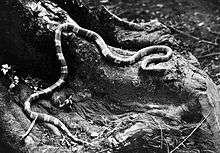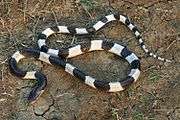Bungarus candidus
| Bungarus candidus | |
|---|---|
 | |
| Scientific classification | |
| Kingdom: | Animalia |
| Phylum: | Chordata |
| Subphylum: | Vertebrata |
| Class: | Reptilia |
| Order: | Squamata |
| Suborder: | Serpentes |
| Family: | Elapidae |
| Genus: | Bungarus |
| Species: | B. candidus |
| Binomial name | |
| Bungarus candidus (Linnaeus, 1758) | |
| Synonyms | |
|
Coluber candidus Linnaeus, 1758 | |
Bungarus candidus, commonly known as the Malayan krait or blue krait, is a species of krait, a venomous elapid snake.
Description and Explanation
The Malayan krait may attain a total length of 108 cm (about 3.5 ft), with a tail 16 cm (6.3 in) long.
Dorsally, it has a pattern of 27-34 dark-brown, black, or bluish-black crossbands on the body and tail, which are narrowed and rounded on the sides. The first crossband is continuous with the dark color of the head. The dark crossbands are separated by broad, yellowish-white interspaces, which may be spotted with black. Ventrally, it is uniformly white.
The smooth dorsal scales are arranged in 15 rows, with the vertebral row much enlarged. The ventrals number 195-237; the anal plate is entire; and the single (undivided) subcaudals are 37-56 in number.[2]
Habitation
It is found in southeast Asia from Indochina south to Java and Bali in Indonesia.
Venom
In mice, the IV LD50 for this species is 0.1 mg/kg.[3] It has caused an untreated mortality rate of 60-70% on humans.[4]
References
![]() Media related to Bungarus candidus at Wikimedia Commons
Media related to Bungarus candidus at Wikimedia Commons
- ↑ Wogan, G.; Vogel, G.; Grismer, L.; Chan-Ard, T. & Nguyen, T.Q. (2012). "Bungarus candidus". IUCN Red List of Threatened Species. Version 2013.1. International Union for Conservation of Nature. Retrieved 18 November 2013.
- ↑ Boulenger, G.A. 1896. Catalogue of the Snakes in the British Museum (Natural History), Volume III. London. p. 368.
- ↑ Tan, Nget Hong. "Toxins from Venoms of Poisonous Snake Indigenous to Malaysia: A Review". Department of Molecular Medicine, Faculty of Medicine. University of Malaya. Retrieved 21 October 2013.
- ↑ "Clinical Toxinology-Bungarus candidus". Clinical Toxinology Resources. University of Adelaide.
Mortality rate:70%
- Das, Indraneil (2010). A Field Guide to the Reptiles of South-East Asia. New Holland Publishers. ISBN 978-1-84773-347-4

